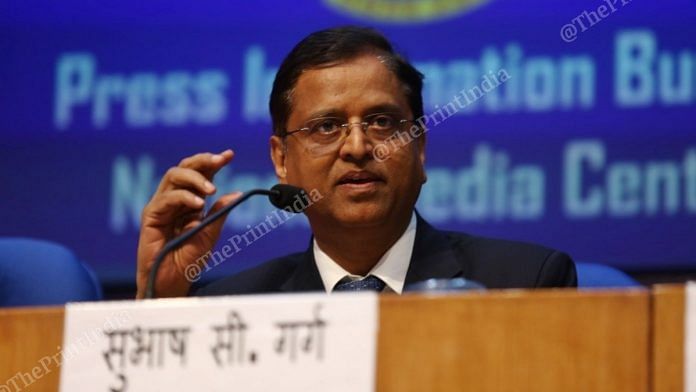New Delhi: Former finance secretary Subhash Chandra Garg has said it is time for India to come clean on its fiscal deficit numbers.
In an interview with ThePrint ahead of the Union budget, Garg said there may not be much fiscal space for an expansionary budget, adding that the country’s real fiscal deficit could reach 5 per cent of GDP in 2019-20 after including all off-budget liabilities.
“The deficit is much larger than what is stated in the budget papers. Over the years, in the interest of sticking to the fiscal deficit glide path, some liabilities have been shifted out of the budget. This is the time to come clean and bring the off-budget borrowings in the budget,” Garg said.
“It will make the budget process and budget numbers far more credible. Markets will find it much more credible,” he said.
Garg said the target of 3 per cent fiscal deficit, to be achieved by 2020-21 according to the Fiscal Responsibility and Management Act, may not be possible. Instead, he said the government could use this opportunity to account for all liabilities in one go in the budget, and set a new glide path.
“The challenge will be to bring the off-budget liabilities into the budget and then to redesign or reshape the fiscal deficit glide path after bringing in all that is outside,” Garg said.
Garg took over as India’s economic affairs secretary in June 2017, and was part of the budget-making team of the finance ministry for the 2018 budget, 2019 interim budget, and the main budget presented in July last year. He opted for voluntary retirement from the Indian Administrative Service soon after, after being transferred to the power ministry.
He estimated that adding the off-budget borrowings for the previous years, India’s actual fiscal deficit was 4.4 per cent in 2017-18 and 4.7 per cent in 2018-19.
Also read: Like his tenure as finance secretary, IAS officer Subhash Garg’s exit was also on own terms
First two years of Modi govt were transparent
Garg said the budgeting system was transparent in 2014-15 and 2015-16, the first two years of the Narendra Modi government.
“Sometimes, it so happens that when you have set a goal for yourself and it looks difficult to achieve, sometimes you get swayed by the feeling that these are temporary factors, and that’s when it starts,” he said.
“It happened earlier when oil and fertiliser bonds were issued outside the consolidated fund account. This time, it has happened with fully serviced bonds, recapitalisation bonds for banks, and meeting some liabilities of food subsidy from the National Small Savings Fund. These were resorted to (in order) to stick to the fiscal glide path,” Garg said.
Also read: Modi govt’s major tool to save India from US-Iran conflict’s fallout – 2020 Budget
No space for expansionary budget
Garg pointed out that a slowing economy remains a challenge, but said there is no fiscal space for an expansionary budget, given the considerable shortfall expected in revenues.
India had budgeted a fiscal deficit of 3.3 per cent of GDP for 2019-20, but it is expected to overshoot this target, with slowing tax revenues and disinvestment proceeds expected to fall well below targets.
“The revenue growth is budgeted at 25 per cent over the actual collections. But none of the tax revenues are growing in double digits. There is likely to be a shortfall of Rs 2.25 lakh crore to Rs 2.5 lakh crore in tax revenues,” he said.
According to Garg, the fiscal deficit could increase to 3.7-4 per cent, and if one adds off-budget liabilities, it could rise to 5 per cent in 2019-20.
“Growth will not come by the government loosening the purse strings. It will come if investment picks up in the economy and the investment is made by the private sector,” he said.
Garg, who has been a proponent for a sovereign bond issuance, said such a move would have helped reduce the government borrowing from the domestic market, opening up more space for the private sector, reducing pressure on interest rates, and lowering the government’s cost of borrowing.
Also read: 5.5% inflation is transitory, it shouldn’t prevent a fiscal boost in Budget 2020







There is great wastage and wanton destruction of funds and properties as well as time of Goverment authorities.The wastage and wanton destruction is not being taken into account as the officers/politiocians are hand in glove /both are corrupted,or else there is no authority to check wastagee and wanton destruction of Govt funds and the buck is passed on to the state/central exchequer under falsehoods.the comptroller and auditor general’s report carries no meaning as he is a toothless tiger and cannot do anything about the wastages and wanton destruction except to write it off to the Central goverment.Time Authorities woke up and found money does not grow on trees.
His views are very conservative ,like the investment would come from private sector.
I f there is economic glut ,(don’t know who has caused it), how can you expect private sector to invest?
No space for expansionary or quantitative easing,when so much of the bank default amount has been absorbed by the system
and banks have not become broke?
Why not Govt , take the lead in Investment by mobilizing public savings and private sector will follow suit.
Why is it all these shenanigans are made public when one retires . It cant be a case that Sri Garg was unaware of what was going on off-balance sheet when he was the FS
He was the inside man. He can tell the country what’s wrong with the numbers. Incidentally, he has joined the rank of opposition and has become a government baiter. Views and opinions of such people are usually suspect.